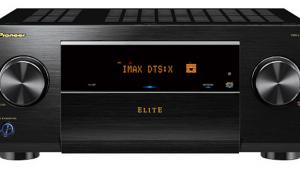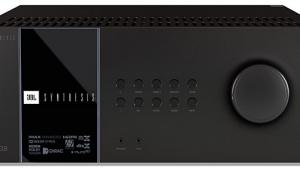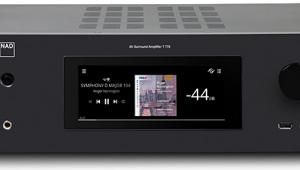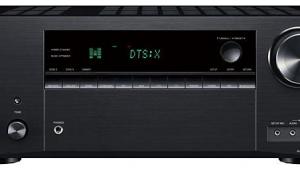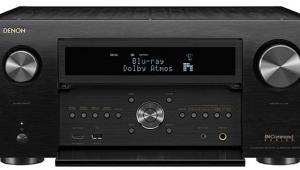Denon AVR-4810CI A/V Receiver Page 3
Paranoid Ears
This resolve lasted all of five minutes. That’s how far I got into Paranoid Park (BD, DTS-HD Master Audio) before curiosity got the better of me. This Gus Van Sant film follows a skateboarding teen through rites of passage fraught with guilt feelings. The movie has an unusually rich soundtrack that’s designed to convey psychological depth and complexity. It features many kinds of music and effects—including a whole lot of phasey, reverb-heavy information. The DSX processing picked up on that. It frequently imparted a hollow, disembodied feel to the kid’s monotone voiceover and many other elements. At one point, as he pulls up a chair to be interviewed by a police detective, the chair scraping the floor had the same defocused sound.

The more I A/B’d, the more I realized that much of the hollowness was encoded directly into the original 5.1-channel soundtrack. Still, DSX exaggerated it slightly. And it did so more than the Dolby Pro Logic IIz mode, which has only height channels and no width. Vocals mixed solely into the center channel weren’t affected; only those that leaked into the front left and right channels. They were then picked up by the DSX height/width processor. I wondered if the problem was coloration induced by the smaller, plastic-clad Cinema 70 in the width and height channels.
As it turned out, the speakers weren’t the problem. In Away We Go (DVD, Dolby Digital 5.1), none of these problems recurred. There was clearly something about the Van Sant movie and its unusual soundtrack that triggered problems in DSX. In the first movie, surf sounded unnatural in nine channels. In the second movie, it sounded perfectly natural, and the difference between five and nine channels was surprisingly subtle. So the problem was source dependent, and I stopped worrying about it. By the way, Maya Rudolph shines in this brilliant comedy as a pregnant woman who accompanies her partner on a freak-filled cross-country journey that defines their love and commitment. Musical interludes by singer/songwriter Alexi Murdoch are reminiscent of Nick Drake, with a sonorous, velvety vocal texture that the Denon mined for beauty and sensuality.
In Ghost Rider (BD, Dolby TrueHD), the hollowness showed up again in yet another opening voiceover, this time by a resonant baritone. But the effect was minimal and didn’t distract me. Nicolas Cage stars as a motorcycle stunt rider who tries to get out of a deal he makes with the devil. Effects include lots of motor noise and all the supernatural effects you’d expect in a movie where Peter Fonda plays Mephistopheles. Naturally, I spared myself the worst onslaughts by invoking Audyssey Dynamic Volume and Dynamic EQ. Dynamic Volume has three settings: Day, with the “least adjustment to loudest and softest sounds”; Evening, with “medium adjustment”; and Midnight, with the “most adjustment.” (This seems to be Denon nomenclature. Marantz, its sister brand, uses the terms Light, Medium, and Heavy.) I compromised and went with Evening. It felt just right. The loudest moments were dramatic but not overbearing, and I didn’t miss a word of dialogue. I also liked MultEQ XT’s effect on the Paradigm Studio 20s. It got some extra low-frequency oomph out of them, which benefited both music and effects. Top-drawer amplification surely helped.
Violin, Piano, Guitar
The Overtures & Concerti Vol. 1 of Francesco Maria Veracini comes in the form of a freshly recorded multichannel SACD on the CPO label. I played the 5.1-channel
mix without enhancement. Like Vivaldi, Veracini was an 18th-
century composer/violinist, so it’s fitting that these pieces are per-
formed by a conductor/violinist, Federico Guglielmo, with the L’Arte dell’Arco, an original-instruments ensemble. Surprises ensued immediately. The “Over-
ture VI in G minor” added reeds to the string orchestra, giving them a leading melodic role, and the recording gave them pride of place in the center channel. This was an unusual mix for an unusual piece. The oboe and bass-
oon had the kind of luminous, sensuous, palpably real feel that’s difficult to achieve on CD but much easier on SACD. In later pieces, Guglielmo’s solo violin parts had plenty of wood tone (I could sense the body of the instrument), and tiny details of the violinist’s touch came through with abundant detail and reso-
lution at every turn. However, this high-frequency virtuosity didn’t come at the expense of listening comfort. Fed with this best-case source material, the Denon wowed me.
Keith Jarrett’s The Köln Concert is the best of his improvised piano records as well as a superb recording. The vinyl is an old friend. After brief and uneventful experimentation with various modes, I chose the Pure mode. This presented source material without enhancement, in its original number of channels, and it shut down the GUI and front-panel display to reduce nonessential circuit-induced noise. The piano sound was limpid and involving. As a listener who’s accustomed to surround expansion, I found the original stereo a little speaker-bound. But my brain soon rewired itself to compensate—in much the same way it rewires itself to accommodate the idiosyncrasies of stereo-to-surround rechanneling. I know every note of this double-LP set by heart, and this demo was among the best I’ve heard. It reminded me that without competence in the fundamentals of audio performance—clarity, low noise, dynamic distinctions large and small—an A/V receiver would be useless to music lovers.
Road to Ruin is the fourth album by the Ramones and the first to feature my namesake, Marky Ramone, on drums. Few of their thousands of imitators have ever approached Johnny’s metal virtuosity, Joey’s sly self- deprecating wit, and the native charm of this quintessential New York band. The album’s showcase of electric guitar textures took on added variety and vividness via Denon’s squeaky-clean amplification. Smoothed a little by my tube phono preamp, the AVR sup- ported high-volume listening, and that’s the most natural way to hear the Ramones. I loved what MultEQ XT did for Marky and Dee Dee’s driving beat. A good sub could have done better, but with EQ, the Paradigms’ slightly reticent metal-coned woofers were musically sufficient.
I finished the audio demos by replaying “I Wanna Be Sedated” in Pure, the Dolby Pro Logic II Music 5.1 mode, and DSX (which will work only in the presence of a 5.1- channel signal like DPLII—not with a stereo signal). Since the Ramones work best with some density, the Pure mode triumphed, DPLII was merely adequate, and the final overlay of DSX was just way too diffuse.
The Denon AVR-4810CI has the most complete feature set I’ve ever encountered in an A/V receiver, with a learning curve to match—but it’s worth the effort. Its performance is up there with the best. This AVR isn’t just for the com- pletist who wants all of the latest listening modes. It’s for anyone who wants a great-sounding system, whether 5.1, 7.1, or 9.1. That kind of supersizing will never go out of style. For the dedicated surround buff who wants it all, here it is.


